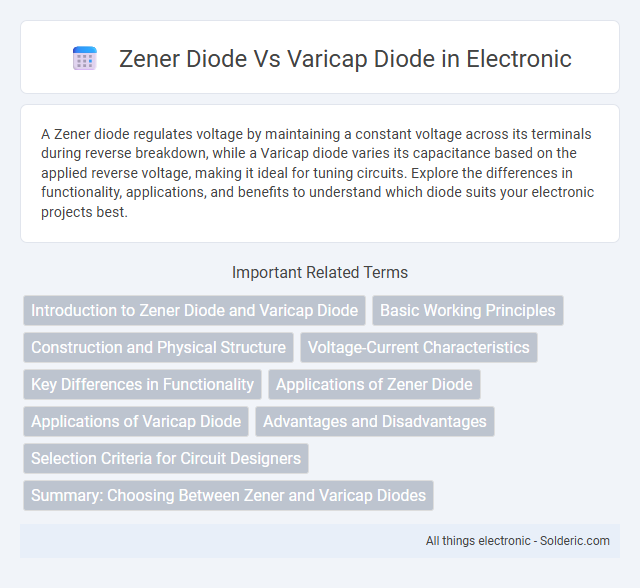A Zener diode regulates voltage by maintaining a constant voltage across its terminals during reverse breakdown, while a Varicap diode varies its capacitance based on the applied reverse voltage, making it ideal for tuning circuits. Explore the differences in functionality, applications, and benefits to understand which diode suits your electronic projects best.
Comparison Table
| Feature | Zener Diode | Varicap Diode |
|---|---|---|
| Primary Function | Voltage regulation and voltage reference | Voltage-controlled capacitance for tuning circuits |
| Operation Principle | Breakdown voltage conduction (Zener breakdown) | Voltage-dependent capacitance variation (varactor effect) |
| Typical Application | Voltage stabilizers, surge protectors | RF tuning, voltage-controlled oscillators (VCOs) |
| Biasing | Reverse biased at breakdown voltage | Reverse biased below breakdown voltage |
| Capacitance | Constant, not used as a capacitor | Variable capacitance dependent on applied voltage |
| Voltage Range | Fixed breakdown voltage (e.g., 3.3V to 200V) | Variable capacitance within a reverse voltage range (1V to 50V typical) |
| Power Dissipation | Can dissipate significant power at breakdown | Minimal power dissipation |
| Symbol | Zener diode symbol (similar to regular diode with bent edges) | Varicap diode symbol (diode with capacitor representation) |
| Package Types | Standard diode packages (DO-35, etc.) | Standard diode packages optimized for low capacitance |
Introduction to Zener Diode and Varicap Diode
Zener diodes regulate voltage by allowing current to flow in the reverse breakdown region, maintaining a stable reference voltage in circuits. Varicap diodes, also known as varactor diodes, function as voltage-controlled capacitors, varying capacitance with applied reverse bias voltage to enable frequency tuning in RF and microwave circuits. Both components are essential in electronic design, with Zener diodes providing voltage regulation while Varicap diodes enable precise frequency control.
Basic Working Principles
Zener diodes operate by allowing current to flow in the reverse direction when the voltage exceeds a specific breakdown level, stabilizing voltage in circuits. Varicap diodes, also known as varactor diodes, change their capacitance based on the reverse voltage applied, enabling voltage-controlled tuning in RF applications. Your choice between these diodes depends on whether voltage regulation (Zener) or variable capacitance (Varicap) is required for the circuit design.
Construction and Physical Structure
Zener diodes feature a heavily doped p-n junction designed to operate in reverse breakdown mode, enabling voltage regulation by maintaining a stable reference voltage. Varicap diodes, also called varactor diodes, have a p-n junction with a lightly doped region, functioning as a voltage-controlled capacitor whose capacitance varies with the applied reverse-bias voltage. Your choice between these diodes depends on the required functionality: voltage stabilization for Zener diodes versus tunable capacitance for Varicap diodes.
Voltage-Current Characteristics
Zener diodes exhibit a sharp breakdown voltage where the current increases rapidly while maintaining a stable voltage, making them ideal for voltage regulation. Varicap diodes show a voltage-dependent capacitance with minimal current flow, primarily used in tuning circuits. Your choice depends on whether stable voltage control or variable capacitance is required for your application.
Key Differences in Functionality
Zener diodes are designed primarily for voltage regulation by maintaining a constant voltage across a load when reverse biased beyond their breakdown voltage. Varicap diodes, also known as varactor diodes, function as voltage-controlled capacitors, varying their capacitance in response to changes in reverse bias voltage, and are commonly used in tuning circuits. The key difference lies in their application: Zener diodes stabilize voltage, while varicap diodes enable electronic tuning by altering capacitance.
Applications of Zener Diode
Zener diodes are primarily used for voltage regulation in power supplies, ensuring a stable output voltage despite variations in input voltage or load conditions. They act as voltage references in precision voltage regulators and protect circuits by clamping voltage surges in surge protectors. Zener diodes also find applications in waveform clipping, voltage shifters, and switching operations within electronic circuits.
Applications of Varicap Diode
Varicap diodes are predominantly used in voltage-controlled tuning applications such as RF oscillators, frequency modulators, and phase-locked loops due to their ability to vary capacitance with applied voltage. Unlike Zener diodes that provide voltage regulation and overvoltage protection, Varicap diodes enable electronic tuning of radio receivers, TV tuners, and automatic frequency control circuits. Your electronic design benefits from Varicap diodes when precise, voltage-dependent tuning of resonant circuits is required for efficient frequency modulation and demodulation.
Advantages and Disadvantages
Zener diodes excel in voltage regulation due to their precise breakdown voltage, offering stable reference voltages in power supplies but exhibit higher leakage currents and are less effective at high frequencies. Varicap diodes provide variable capacitance controlled by reverse voltage, making them ideal for tuning circuits and frequency modulation, yet they suffer from lower Q factors and limited voltage handling compared to other capacitor types. While Zener diodes prioritize voltage stability, Varicap diodes emphasize frequency agility, each with trade-offs in leakage, response times, and application-specific limitations.
Selection Criteria for Circuit Designers
Circuit designers select Zener diodes primarily for voltage regulation and voltage reference applications due to their precise breakdown voltage characteristics and stable reverse voltage operation. Varicap diodes are chosen when variable capacitance is needed, such as in tuning circuits or frequency modulation, because their junction capacitance changes with applied reverse bias voltage. Your decision hinges on whether the application demands voltage stabilization (Zener) or voltage-controlled capacitance (Varicap).
Summary: Choosing Between Zener and Varicap Diodes
Zener diodes are primarily used for voltage regulation by maintaining a stable reference voltage in circuits, while varicap diodes function as voltage-controlled capacitors for tuning and frequency modulation. Your choice depends on whether voltage stabilization or variable capacitance for frequency adjustment is required. Selecting the right diode ensures optimal performance in applications like power supplies or RF circuits.
Zener diode vs Varicap diode Infographic

 solderic.com
solderic.com